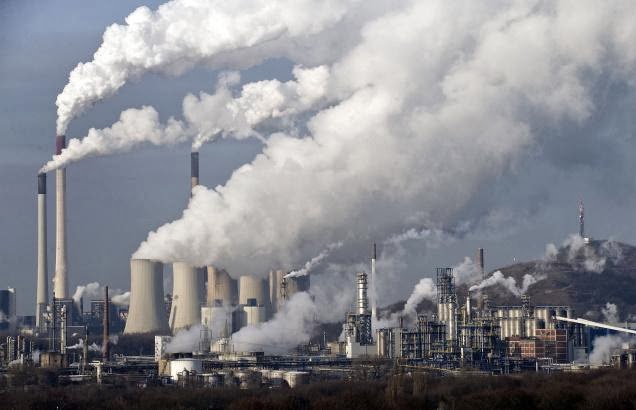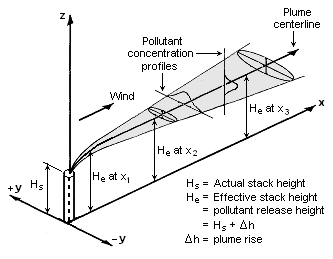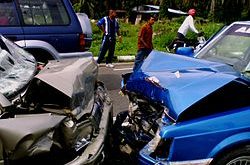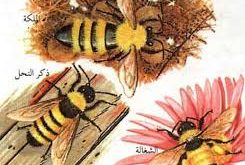Air pollution is the introduction ofchemicals,particulates,biological materials,
or other harmful materials into theEarth’s atmosphere,
possibly causing disease,
death to humans,
damage to other living organisms such as food crops,
or thenatural orbuilt environment.
The atmosphere is a complex natural gaseous system that is essential to support life on planetEarth.Stratosphericozone depletion due to air pollution has long been recognized as a threat to human health as well as to the Earth’secosystems.
Indoor air pollution (seeAirlog) and urban air quality are listed as two of the world’s worst toxic pollution problems in the 2008Blacksmith Institute World’s Worst Polluted Places report.[1]
Pollutants
Schematic drawing,
causes and effects of air pollution: (1) greenhouse effect,
(2) particulate contamination,
(3) increased UV radiation,
(4) acid rain,
(5) increased ground level ozone concentration,
(6) increased levels of nitrogen oxides.
An air pollutant is a substance in the air that can have adverse effects on humans and the ecosystem.
The substance can be solid particles,
liquid droplets,
or gases.
A pollutant can be of natural origin or man-made.
Pollutants are classified as primary or secondary.
Primary pollutants are usually produced from a process,
such as ash from a volcanic eruption.
Other examples includecarbon monoxide gas from motor vehicle exhaust,
or thesulfur dioxide released from factories.
Secondary pollutants are not emitted directly.
Rather,
they form in the air when primary pollutants react or interact.Ground level ozone is a prominent example of a secondary pollutant.
Some pollutants may be both primary and secondary: they are both emitted directly and formed from other primary pollutants.
Major primary pollutants produced by human activity include:
- Sulfur oxides (SOx) – particularly sulfur dioxide,
a chemical compound with the formula SO2.
SO2 is produced by volcanoes and in various industrial processes.
Coal and petroleum often contain sulfur compounds,
and their combustion generates sulfur dioxide.
Further oxidation of SO2,
usually in the presence of a catalyst such as NO2,
forms H2SO4,
and thusacid rain.[2] This is one of the causes for concern over the environmental impact of the use of these fuels as power sources. - Nitrogen oxides (NOx) – Nitrogen oxides,
particularlynitrogen dioxide,
are expelled from high temperature combustion,
and are also produced duringthunderstorms byelectric discharge.
They can be seen as a brownhaze dome above or aplume downwind of cities.
Nitrogen dioxide is a chemical compound with the formula NO2.
It is one of several nitrogen oxides.
One of the most prominent air pollutants,
this reddish-brown toxic gas has a characteristic sharp,
biting odor.
- Carbon monoxide (CO)- CO is a colourless,
odourless,
toxic yet non-irritating gas.
It is a product byincomplete combustion of fuel such as natural gas,
coal or wood.
Vehicular exhaust is a major source of carbon monoxide.
- Volatile organic compounds – VOCs are a well known outdoor air pollutant.
They are categorized as either methane (CH4) or non-methane (NMVOCs).
Methane is an extremely efficient greenhouse gas which contributes to enhancedglobal warming.
Other hydrocarbon VOCs are also significant greenhouse gases because of their role in creating ozone and prolonging the life of methane in the atmosphere.
This effect varies depending on local air quality.
The aromatic NMVOCs benzene,
toluene and xylene are suspected carcinogens and may lead to leukemia with prolonged exposure.
1,3-butadiene is another dangerous compound often associated with industrial use.
- Particulates,
alternatively referred to as particulate matter (PM),
atmospheric particulate matter,
or fine particles,
are tiny particles of solid or liquid suspended in a gas.
In contrast,
aerosol refers to combined particles and gas.
Some particulates occur naturally,
originating from volcanoes,
dust storms,
forest and grassland fires,
living vegetation,
and sea spray.
Human activities,
such as the burning of fossil fuels in vehicles,
power plants and various industrial processes also generate significant amounts of aerosols.
Averaged worldwide,
anthropogenic aerosols—those made by human activities—currently account for approximately 10 percent of our atmosphere.
Increased levels of fine particles in the air are linked to health hazards such as heart disease,[2] altered lung — # و صله ممنوعه 1778 # — and lung cancer.
- Persistent free radicals connected to airborne fine particles are linked to cardiopulmonary disease.[3][4]
- Toxicmetals,
such aslead andmercury,
especially their compounds. - Chlorofluorocarbons (CFCs) – harmful to theozone layer; emitted from products currently banned from use <–
These are gases which are released from air conditioners,
refrigerators,
aerosol sprays,
etc.
CFC’s on being released into the air rises tostratosphere.
Here they come in contact with other gases and damage theozone layer.
This allows harmful ultraviolet rays to reach the earth’s surface.
This can lead to skin cancer,
disease to eye and can even cause damage to plants.
- Ammonia (NH3) – emitted from agricultural processes.
Ammonia is a compound with the formula NH3.
It is normally encountered as a gas with a characteristic pungent odor.
Ammonia contributes significantly to the nutritional needs of terrestrial organisms by serving as a precursor to foodstuffs and fertilizers.
Ammonia,
either directly or indirectly,
is also a building block for the synthesis of many pharmaceuticals.
Although in wide use,
ammonia is both caustic and hazardous. - Odors — such as from garbage,
sewage,
and industrial processes - Radioactive pollutants – produced bynuclear explosions,
nuclear events,
warexplosives,
and natural processes such as theradioactive decay ofradon.
.
Secondary pollutants include:
- Particulates created from gaseous primary pollutants and compounds in photochemical smog.Smog is a kind of air pollution.
Classic smog results from large amounts of coal burning in an area caused by a mixture of smoke and sulfur dioxide.
Modern smog does not usually come from coal but from vehicular and industrial emissions that are acted on in the atmosphere byultraviolet light from the sun to form secondary pollutants that also combine with the primary emissions to form photochemical smog. - Ground level ozone (O3) formed from NOx and VOCs.
Ozone (O3) is a key constituent of the troposphere.
It is also an important constituent of certain regions of the stratosphere commonly known as the Ozone layer.
Photochemical and chemical reactions involving it drive many of the chemical processes that occur in the atmosphere by day and by night.
At abnormally high concentrations brought about by human activities (largely the combustion of fossil fuel),
it is a pollutant,
and a constituent of smog. - Peroxyacetyl nitrate (PAN) – similarly formed from NOx and VOCs.
Minor air pollutants include:
- A large number of minorhazardous air pollutants.
Some of these are regulated in USA under theClean Air Act and in Europe under the Air Framework Directive - A variety ofpersistent organic pollutants,
which can attach to particulates
Persistent organic pollutants (POPs) are organic compounds that are resistant to environmental degradation through chemical,
biological,
and photolytic processes.
Because of this,
they have been observed to persist in the environment,
to be capable of long-range transport,
bioaccumulate in human and animal tissue,
biomagnify in food chains,
and to have potential significant impacts on human health and the environment.
Sources
Controlled burning of a field outside ofStatesboro,Georgia in preparation for spring planting
There are various locations,
activities or factors which are responsible for releasing pollutants into the atmosphere.
These sources can be classified into two major categories.
Anthropogenic (man-made) sources:
These are mostly related to the burning of multiple types of fuel.
- Stationary Sources include smoke stacks ofpower plants,
manufacturing facilities (factories) and waste incinerators,
as well as furnaces and other types of fuel-burning heating devices.
In developing and poor countries,
traditional biomass burning is the major source of air pollutants; traditional biomass includes wood,
crop waste and dung.[5][6]
- Mobile Sources includemotor vehicles,
marine vessels,
and aircraft.
- Chemicals’,
dust andcontrolled burn practices in agriculture and forest management’.
Controlled or prescribed burning is a technique sometimes used in forest management,
farming,
prairie restoration or greenhouse gas abatement.
Fire is a natural part of both forest and grassland ecology and controlled fire can be a tool for foresters.
Controlled burning stimulates the germination of some desirable forest trees,
thus renewing the forest.
- Fumes frompaint,hair spray,varnish,aerosol sprays and other solvents
- Waste deposition inlandfills,
which generatemethane.
Methane is highly flammable and may form explosive mixtures with air.
Methane is also anasphyxiant and may displace oxygen in an enclosed space.
Asphyxia or suffocation may result if the oxygen concentration is reduced to below 19.5% by displacement.
- Military resources,
such asnuclear weapons,toxic gases,germ warfare androcketry
Natural sources:
- Dust from natural sources,
usually large areas of land with few or no vegetation - Methane,emitted by thedigestion of food byanimals,
for examplecattle - Radon gas fromradioactive decay within theEarth’s crust.
Radon is a colorless,
odorless,
naturally occurring,
radioactive noble gas that is formed from the decay of radium.
It is considered to be a health hazard.
Radon gas from natural sources can accumulate in buildings,
especially in confined areas such as the basement and it is the second most frequent cause of lung cancer,
aftercigarette smoking.
- Smoke andcarbon monoxide fromwildfires
- Vegetation,
in some regions,
emits environmentally significant amounts of VOCs on warmer days.
These VOCs react with primary anthropogenic pollutants—specifically,
NOx,
SO2,
and anthropogenic organic carbon compounds—to produce a seasonal haze of secondary pollutants.[7] - Volcanic activity,
which producessulfur,chlorine,
and ash particulates
Emission factors
Industrial air pollution emissions
Air pollutant emission factors are representative values that people attempt to relate the quantity of a pollutant released to the ambient air with an activity associated with the release of that pollutant.
These factors are usually expressed as the weight of pollutant divided by a unit weight,
volume,
distance,
or duration of the activity emitting the pollutant (e.g.,
kilograms of particulate emitted pertonne of coal burned).
Such factors facilitate estimation of emissions from various sources of air pollution.
In most cases,
these factors are simply averages of all available data of acceptable quality,
and are generally assumed to be representative of long-term averages.
There are 12 compounds in the list of POPs.
Dioxins and furans are two of them and are intentionally created by combustion of organics,
like open burning of plastics.
The POPs are also endocrine disruptors and can mutate the human genes.
TheUnited States Environmental Protection Agency has published a compilation of air pollutant emission factors for a multitude of industrial sources.[8]TheUnited Kingdom,Australia,Canada and many other countries have published similar compilations,
as well as theEuropean Environment Agency.[9][10][11][12]
Air pollution exposure
Air pollution risk is a — # و صله ممنوعه 1778 # — of the hazard of the pollutant and the exposure to that pollutant.
Air pollution exposure can be expressed for an individual,
for certain groups (e.g.
neighborhoods or children living in a county),
or for entire populations.
For example,
one may want to calculate the exposure to a hazardous air pollutant for a geographic area,
which includes the various microenvironments and age groups.
This can be calculated[13] as an inhalation exposure.
This would account for daily exposure in various settings (e.g.
different indoor micro-environments and outdoor locations).
The exposure needs to include different age and other demographic groups,
especially infants,
children,
pregnant women and other sensitive subpopulaitons.
The exposure to an air pollutant must integrate the concentrations of the air pollutant with respect to the time spent in each setting and the respective inhalation rates for each subgroup for each specific time that the subgroup is in the setting and engaged in particular activities (playing,
cooking,
reading,
working,
etc.).
For example,
a small child’s inhalation rate will be less than that of an adult.
A child engaged in vigorous exercise will have a higher respiration rate than the same child in a sedentary activity.
The daily exposure,
then,
needs to reflect the time spent in each micro-environmental setting and the type of activities in these settings.
The air pollutant concentration in each microactivity/microenvironmental setting is summed to indicate the exposure.[13]
Indoor air quality (IAQ)
Air quality monitoring,
New Delhi,
India.
A lack of ventilation indoors concentrates air pollution where people often spend the majority of their time.
Radon (Rn) gas,
acarcinogen,
is exuded from the Earth in certain locations and trapped inside houses.
Building materials includingcarpeting andplywood emitformaldehyde (H2CO) gas.
Paint and solvents give offvolatile organic compounds (VOCs) as they dry.Lead paint can degenerate intodust and be inhaled.
Intentional air pollution is introduced with the use ofair fresheners,incense,
and other scented items.
Controlled wood fires in stoves andfireplaces can add significant amounts of smoke particulates into the air,
inside and out.[14] Indoor pollution fatalities may be caused by usingpesticides and other chemical sprays indoors without proper ventilation.
Carbon monoxide (CO) poisoning and fatalities are often caused by faulty vents and chimneys,
or by the burning ofcharcoal indoors.
Chroniccarbon monoxide poisoning can result even from poorly adjustedpilot lights.
Traps are built into all domesticplumbing to keep sewer gas andhydrogen sulfide,
out of interiors.
Clothing emitstetrachloroethylene,
or other dry cleaning fluids,
for days afterdry cleaning.
Though its use has now been banned in many countries,
the extensive use ofasbestos in industrial and domestic environments in the past has left a potentially very dangerous material in many localities.Asbestosis is a chronicinflammatory medical condition affecting the tissue of thelungs.
It occurs after long-term,
heavy exposure to asbestos from asbestos-containing materials in structures.
Sufferers have severedyspnea (shortness of breath) and are at an increased risk regarding several different types oflung cancer.
As clear explanations are not always stressed in non-technical literature,
care should be taken to distinguish between several forms of relevant diseases.
According to theWorld Health Organisation (WHO),
these may defined as;asbestosis,lung cancer,
andPeritoneal Mesothelioma (generally a very rare form of cancer,
when more widespread it is almost always associated with prolonged exposure to asbestos).
Biological sources of air pollution are also found indoors,
as gases and airborne particulates.Pets produce dander,
people produce dust from minute skin flakes and decomposed hair,
dustmites in bedding,
carpeting and furniture produce enzymes and micrometre-sized fecal droppings,
inhabitants emit methane,moldforms in walls and generatesmycotoxins and spores,air conditioning systems can incubateLegionnaires’ disease and mold,
andhouseplants,
soil and surroundinggardens can producepollen,
dust,
and mold.
Indoors,
the lack of air circulation allows these airborne pollutants to accumulate more than they would otherwise occur in nature.
Health effects
Air pollution is a significant risk factor for multiple health conditions including respiratory infections,
heart disease,
and lung cancer,
according to the WHO.
The health effects caused by air pollution may include difficulty in breathing,
wheezing,
coughing,asthma and aggravation of existing respiratory and cardiac conditions.
These effects can result in increased medication use,
increased doctor or emergency room visits,
more hospital admissions and premature death.
The human health effects of poor air quality are far reaching,
but principally affect the body’s respiratory system and the cardiovascular system.
Individual reactions to air pollutants depend on the type of pollutant a person is exposed to,
the degree of exposure,
the individual’s health status and genetics.[13] The most common sources of air pollution include particulates,
ozone,
nitrogen dioxide,
and sulfur dioxide.
Both indoor and outdoor air pollution have caused approximately 3.3 million deaths worldwide.
Children aged less than five years that live in developing countries are the most vulnerable population in terms of total deaths attributable to indoor and outdoor air pollution.[15]
The World Health Organization states that 2.4 million people die each year from causes directly attributable to air pollution,
with 1.5 million of these deaths attributable to indoor air pollution.[16] In 2024 the New York Times reported that ‘India has the highest death rate because of chronic respiratory diseases.'[17]”Epidemiological studies suggest that more than 500,000 Americans die each year fromcardiopulmonary disease linked to breathing fine particle air pollution.
.
.”[18] In December 2024 the former health minister ofChina,
Chen Zhu,
a professor of medicine and a leading molecular biologist,
claimed that air pollution was killing 500,000 people in China each year.[19] A study by theUniversity of Birmingham has shown a strong correlation betweenpneumonia related deaths and air pollution from motor vehicles.[20] Worldwide more deaths per year are linked to air pollution than to automobile accidents.[21] A 2005 study by the European Commission calculated that air pollution reduces life expectancy by an average of almost nine months across the European Union.[22] Causes of deaths include aggravated asthma,
emphysema,
lung and heart diseases,
and respiratory allergies.[23] TheUS EPA estimates that a proposed set of changes indiesel engine technology (Tier 2) could result in 12,000 fewerpremature mortalities,
15,000 fewerheart attacks,
6,000 feweremergency room visits by children with asthma,
and 8,900 fewer respiratory-related hospital admissions each year in the United States.[citation needed]
The US EPA estimates allowing a ground-level ozone concentration of 65 parts per billion,
would avert 1,700 to 5,100 premature deaths nationwide in 2024 compared with the current 75-ppb standard.
The agency projects the stricter standard would also prevent an additional 26,000 cases of aggravated asthma,
and more than a million cases of missed work or school.[24][25]
The worst short term civilian pollution crisis inIndia was the 1984Bhopal Disaster.[26] Leaked industrial vapours from the Union Carbide factory,
belonging to Union Carbide,
Inc.,
U.S.A.
(later bought over byDow Chemical Company),
killed more than 25,000 people outright and injured anywhere from 150,000 to 600,000.
The United Kingdom suffered its worst air pollution event when the December 4Great Smog of 1952 formed overLondon.
In six days more than 4,000 died,
and 8,000 more died within the following months.[citation needed] An accidental leak ofanthrax spores from abiological warfare laboratory in the formerUSSR in 1979 nearSverdlovsk is believed to have been the cause of hundreds of civilian deaths.[citation needed] The worst single incident of air pollution to occur in the US occurred inDonora,
Pennsylvania in late October,
1948,
when 20 people died and over 7,000 were injured.[27]
A new economic study of the health impacts and associated costs of air pollution in theLos Angeles Basin andSan Joaquin Valley of Southern California shows that more than 3800 people die prematurely (approximately 14 years earlier than normal) each year because air pollution levels violate federal standards.
The number of annual premature deaths is considerably higher than the fatalities related to auto collisions in the same area,
which average fewer than 2,000 per year.[28][29][30]
Diesel exhaust (DE) is a major contributor to combustion derived particulate matter air pollution.
In several human experimental studies,
using a well validated exposure chamber setup,
DE has been linked to acute vascular dys– # و صله ممنوعه 1778 # — and increased thrombus formation.[31][32] This serves as a plausible mechanistic link between the previously described association between particulates air pollution and increased cardiovascular morbidity and mortality.
Effects on cardiovascular health
A 2007 review of evidence found ambient air pollution exposure is a risk factor correlating with increased total mortality from cardiovascular events (range: 12% to 14% per a 10 microg/m^3 increase).PMID 19235364.
Air pollution is also emerging as a risk factor for stroke,
particularly in developing countries where pollutant levels are highest.[33] A 2007 study found that in women air pollution is associated not with hemorrhagic but with ischemic stroke.[34] Air pollution was also found to be associated with increased incidence and mortality from coronary stroke in a cohort study in 2024.[35] Associations are believed to be causal and effects may be mediated by vasoconstriction,
low-grade inflammation or autonomic nervous system imbalance or other mechanisms.[36][37]
Effects on cystic fibrosis
A study from around the years of 1999 to 2000,
by the University of Washington,
showed that patients near and around particulates air pollution had an increased risk of pulmonary exacerbations and decrease in lung — # و صله ممنوعه 1778 # –.[38] Patients were examined before the study for amounts of specific pollutants likePseudomonas aeruginosa orBurkholderia cenocepacia as well as their socioeconomic standing.
Participants involved in the study were located in the United States in close proximity to anEnvironmental Protection Agency.[39] During the time of the study 117 deaths were associated with air pollution.
Many patients in the study lived in or near large metropolitan areas in order to be close to medical help.
These same patients had higher level of pollutants found in their system because of more emissions in larger cities.
As cystic fibrosis patients already suffer from decreased lung — # و صله ممنوعه 1778 # –,
everyday pollutants such as smoke,
emissions from automobiles,
tobacco smoke and improper use of indoor heating devices could further compromise lung — # و صله ممنوعه 1778 # –.[40]
Effects on COPD and asthma
Chronic obstructive pulmonary disease (COPD) includes diseases such aschronic bronchitis andemphysema.[41]
Researches have demonstrated increased risk of developing asthma[42] and COPD[43] from increased exposure to traffic-related air pollution.
Additionally,
air pollution has been associated with increased hospitalizations and mortality from asthma and COPD.[44][45]
A study conducted in 1960-1961 in the wake of theGreat Smog of 1952 compared 293 London residents with 477 residents of Gloucester,
Peterborough,
and Norwich,
three towns with low reported death rates from chronic bronchitis.
All subjects were male postal truck drivers aged 40 to 59.
Compared to the subjects from the outlying towns,
the London subjects exhibited more severe respiratory symptoms (including cough,
phlegm,
and dyspnea),
reduced lung — # و صله ممنوعه 1778 # — (FEV1 and peak flow rate),
and increased sputum production and purulence.
The differences were more pronounced for subjects aged 50 to 59.
The study controlled for age and smoking habits,
so concluded that air pollution was the most likely cause of the observed differences.[46]
It is believed that much likecystic fibrosis,
by living in a more urban environment serious health hazards become more apparent.
Studies have shown that in urban areas patients suffermucus hypersecretion,
lower levels of lung — # و صله ممنوعه 1778 # –,
and more self diagnosis of chronic bronchitis and emphysema.[47]
Links to cancer
A review of evidence regarding whether ambient air pollution exposure is a risk factor for cancer in 2007 found solid data to conclude that long-term exposure to PM2.5 (fine particulates) increases the overall risk of non-accidental mortality by 6% per a 10 microg/m3 increase.PMID 19235364
The review further noted that living close to busy traffic appears to be associated with elevated risks of these three outcomes increase in lung cancer deaths,
cardiovascular deaths,
and overall non-accidental deaths.PMID 19235364
The reviewers also found suggestive evidence that exposure to PM2.5 is positively associated with mortality from coronary heart diseases and exposure to SO2 increases mortality from lung cancer,
but the data was insufficient to provide solid conclusions.
In 2024,
a large Danish epidemiological study found an increased risk of lung cancer for patients who lived in areas with high nitrogen oxide concentrations.
In this study,
the association was higher for non-smokers than smokers.[48] An additional Danish study,
also in 2024,
likewise noted evidence of possible associations between air pollution and other forms of cancer,
including cervical cancer and brain cancer.[49]
Effects on children
Around the world,
children living in cities with high exposure to air pollutants are at increased risk of developing asthma,
pneumonia and other lower respiratory infections.
Air pollution is also a significant contribution toenvironmental toxins in pregnancy.
TheWorld Health Organization reports that the greatest concentrations of particulates are found in countries with low economic world power and high poverty and population growth rates.
Examples of these countries includeEgypt,Sudan,Mongolia,
andIndonesia.
However even in the United States,
despite the passage of theClean Air Act in 1970,
in 2002 at least 146 million Americans were living innon-attainment areas—regions in which the concentration of certain air pollutants exceeded federal standards.[50] These dangerous pollutants are known as thecriteria pollutants,
and include ozone,
particulates,
sulfur dioxide,
nitrogen dioxide,
carbon monoxide,
and lead.
Protective measures to ensure children’s health are being taken in cities such asNew Delhi,
India where buses now usecompressed natural gas to help eliminate the “pea-soup” smog.[51]
Health effects in relatively “clean” areas
Even in the areas with relatively low levels of air pollution,
public health effects can be significant and costly,
since a large number of people breathe in such pollutants.
A 2005 scientific study for the British Columbia Lung Association showed that a small improvement in air quality (1% reduction of ambient PM2.5 and ozone concentrations) would produce a $29 million in annual savings in theMetro Vancouver region in 2024.[52] This finding is based on health valuation of lethal (death) and sub-lethal (illness) affects.
Reduction efforts
There are various air pollution control technologies andland use planning strategies available to reduce air pollution.[53][54] At its most basic level land use planning is likely to involve zoning and transport infrastructure planning.
In most developed countries,
land use planning is an important part of social policy,
ensuring that land is used efficiently for the benefit of the wider economy and population as well as to protect the environment.
Efforts to reduce pollution from mobile sources includes primary regulation (many developing countries have permissive regulations),[citation needed] expanding regulation to new sources (such ascruise and transport ships,
farm equipment,
and small gas-powered equipment such as lawn trimmers,chainsaws,
andsnowmobiles),
increased fuel efficiency (such as through the use ofhybrid vehicles),
conversion to cleaner fuels (such asbioethanol,biodiesel,
or conversion to electric vehicles).
Titanium dioxide has been researched for it’s ability to reduce air pollution.
Ultra violet light will release free electrons from the material creating free radicals,
breaking up VOCs and NOx gases.
One form is superhydrophilic.[55]
Control devices
The following items are commonly used as pollution control devices by industry or transportation devices.
They can either destroycontaminants or remove them from an exhaust stream before it is emitted into the atmosphere.
- Particulate control
- Mechanical collectors (dust cyclones,
multicyclones) - Electrostatic precipitators An electrostatic precipitator (ESP),
or electrostatic air cleaner is a particulate collection device that removes particles from a flowing gas (such as air) using the force of an induced electrostatic charge.
Electrostatic precipitators are highly efficient filtration devices that minimally impede the flow of gases through the device,
and can easily remove fine particulates such as dust and smoke from the air stream. - Baghouses Designed to handle heavy dust loads,
a dust collector consists of a blower,
dust filter,
a filter-cleaning system,
and a dust receptacle or dust removal system (distinguished from air cleaners which utilize disposable filters to remove the dust).
- Mechanical collectors (dust cyclones,
-
- Particulate scrubbers Wet scrubber is a form of pollution control technology.
The term describes a variety of devices that use pollutants from a furnace flue gas or from other gas streams.
In a wet scrubber,
the polluted gas stream is brought into contact with the scrubbing liquid,
by spraying it with the liquid,
by forcing it through a pool of liquid,
or by some other contact method,
so as to remove the pollutants.
- Particulate scrubbers Wet scrubber is a form of pollution control technology.
- Scrubbers
- Baffle spray scrubber
- Cyclonic spray scrubber
- Ejector venturi scrubber
- Mechanically aided scrubber
- Spray tower
- Wet scrubber
- NOx control
- Low NOx burners
- Selective catalytic reduction (SCR)
- Selective non-catalytic reduction (SNCR)
- NOx scrubbers
- Exhaust gas recirculation
- Catalytic converter (also for VOC control)
- VOC abatement
- Adsorption systems,
such asactivated carbon - Flares
- Thermal oxidizers
- Catalytic converters
- Biofilters
- Absorption (scrubbing)
- Cryogeniccondensers
- Vapor recovery systems
- Adsorption systems,
- Acid Gas/SO2 control
- Wet scrubbers
- Dry scrubbers
- Flue-gas desulfurization
- Mercury control
- Sorbent Injection Technology
- Electro-Catalytic Oxidation (ECO)
- K-Fuel
- Dioxin andfuran control
- Miscellaneous associated equipment
- Source capturing systems
- Continuous emissions monitoring systems (CEMS)
Legal regulations
In general,
there are two types of air quality standards.
The first class of standards (such as the U.S.National Ambient Air Quality Standards and E.U.Air Quality Directive) set maximum atmospheric concentrations for specific pollutants.
Environmental agencies enact regulations which are intended to result in attainment of these target levels.
The second class (such as the North AmericanAir Quality Index) take the form of a scale with various thresholds,
which is used to communicate to the public the relative risk of outdoor activity.
The scale may or may not distinguish between different pollutants.
Canada
In Canada air pollution and associated health risks are measured with theAir Quality Health Index or (AQHI).
It is a health protection tool used to make decisions to reduce short-term exposure to air pollution by adjusting activity levels during increased levels of air pollution.
The Air Quality Health Index or “AQHI” is a federal program jointly coordinated byHealth Canada andEnvironment Canada.
However,
the AQHI program would not be possible without the commitment and support of the provinces,
municipalities and NGOs.
From air quality monitoring to health risk communication and community engagement,
local partners are responsible for the vast majority of work related to AQHI implementation.
The AQHI provides a number from 1 to 10+ to indicate the level of health risk associated with local air quality.
Occasionally,
when the amount of air pollution is abnormally high,
the number may exceed 10.
The AQHI provides a local air quality current value as well as a local air quality maximums forecast for today,
tonight and tomorrow and provides associated health advice.
| 1 | 2 | 3 | 4 | 5 | 6 | 7 | 8 | 9 | 10 | + |
| Risk: | Low(1-3) | Moderate(4-6) | High(7-10) | Very high(above 10) |
As it is now known that even low levels of air pollution can trigger discomfort for the sensitive population,
the index has been developed as a continuum: The higher the number,
the greater the health risk and need to take precautions.
The index describes the level of health risk associated with this number as ‘low’,
‘moderate’,
‘high’
or ‘very high’,
and suggests steps that can be taken to reduce exposure.
[56]
| Health Risk | Air Quality Health Index | Health Messages | |
|---|---|---|---|
| At Risk population | General Population | ||
| Low | 1-3 | Enjoy your usual outdoor activities. | Ideal air quality for outdoor activities |
| Moderate | 4-6 | Consider reducing or rescheduling strenuous activities outdoors if you are experiencing symptoms. | No need to modify your usual outdoor activities unless you experience symptoms such as coughing and throat irritation. |
| High | 7-10 | Reduce or reschedule strenuous activities outdoors. Children and the elderly should also take it easy. |
Consider reducing or rescheduling strenuous activities outdoors if you experience symptoms such as coughing and throat irritation. |
| Very high | Above 10 | Avoid strenuous activities outdoors. Children and the elderly should also avoid outdoor physical exertion. |
Reduce or reschedule strenuous activities outdoors, especially if you experience symptoms such as coughing and throat irritation. |
[57]
It is measured based on the observed relationship of Nitrogen Dioxide (NO2),
ground-level Ozone (O3) and particulates (PM2.5) with mortality from an analysis of several Canadian cities.
Significantly,
all three of these pollutants can pose health risks,
even at low levels of exposure,
especially among those with pre-existing health problems.
When developing the AQHI,
Health Canada’s original analysis of health effects included five major air pollutants: particulates,ozone,
andnitrogen dioxide(NO2),
as well assulfur dioxide (SO2),
andcarbon monoxide (CO).
The latter two pollutants provided little information in predicting health effects and were removed from the AQHI formulation.
The AQHI does not measure the effects of odour,pollen,
dust,
heat or humidity.
Germany
TA Luft is the German air quality regime.
Cities
| Thefactual accuracy of parts of this article (those related to the first two images in this section)may be compromised due to out-of-date information.Please update this article to reflect recent events or newly available information.(October 2024) |
Air pollution is usually concentrated in densely populated metropolitan areas,
especially in developing countries where environmental regulations are relatively lax or nonexistent.[58] However,
even populated areas in developed countries attain unhealthy levels of pollution withLos Angeles andRome being two good examples.[59] Between 2002 and 2024 the incidence of lung cancer inBeijing near doubled.
While smoking remains the leading cause of lung cancer in China the number of smokers is falling while lung cancer rates are rising.[60]
National-scale air toxics assessment
Thenational-scale air toxics assessment (NATA) is EPA’s ongoing comprehensive — # و صله ممنوعه 1775 # –uation of air toxics in the U.S.
EPA developed the NATA as a state-of-the-science screening tool for State/Local/Tribal Agencies to prioritize pollutants,
emission sources and locations of interest for further study in order to gain a better understanding of risks.
NATA assessments do not incorporate refined information about emission sources,
but rather,
use general information about sources to develop estimates of risks which are more likely to overestimate impacts than underestimate them.
NATA provides estimates of the risk of cancer and other serious health effects from breathing (inhaling) air toxics in order to inform both national and more localized efforts to identify and prioritize air toxics,
emission source types and locations which are of greatest potential concern in terms of contributing to population risk.
This in turn helps air pollution experts focus limited analytical resources on areas and or populations where the potential for health risks are highest.
Assessments include estimates of cancer and non-cancer health effects based on chronic exposure from outdoor sources,
including assessments of non-cancer health effects for Diesel Particulate Matter (PM).
Assessments provide a snapshot of the outdoor air quality and the risks to human health that would result if air toxic emissions levels remained unchanged.[61]
| Most Polluted World Cities by PM[62] | |
|---|---|
| Particulate matter, μg/m³ (2004) |
City |
| 168 | Cairo,Egypt |
| 150 | Delhi,India |
| 128 | Kolkata, India (Calcutta) |
| 125 | Tianjin,China |
| 123 | Chongqing, China |
| 109 | Kanpur, India |
| 109 | Lucknow, India |
| 104 | Jakarta,Indonesia |
| 101 | Shenyang, China |
Governing urban air pollution – a regional example (London)
InEurope,
Council Directive 96/62/EC on ambient air quality assessment and management provides a common strategy against whichmember states can “set objectives for ambient air quality in order to avoid,
prevent or reduce harmful effects on human health and the environment .
.
.
and improve air quality where it is unsatisfactory”.[63]
On 25 July 2008 in the case Dieter Janecek v Freistaat Bayern CURIA,
theEuropean Court of Justice ruled that under this directive[63] citizens have the right to require national authorities to implement a short term action plan that aims to maintain or achieve compliance to air quality limit values.[64]
This importantcase law appears to confirm the role of the EC as centralised regulator to European nation-states as regards air pollution control.
It places asupranational legal obligation on the UK to protect its citizens from dangerous levels of air pollution,
furthermore superseding national interests with those of the citizen.
In 2024,
theEuropean Commission (EC) threatened the UK with legal action against the successive breaching ofPM10 limit values.[65] The UK government has identified that if fines are imposed,
they could cost the nation upwards of £300 million per year.[66]
In March 2024,
theCity of London remains the only UK region in breach of the EC’s limit values,
and has been given 3 months to implement an emergency action plan aimed at meeting the EU Air Quality Directive.[67] The City of London has dangerous levels of PM10 concentrations,
estimated to cause 3000 deaths per year within the city.[68] As well as the threat of EU fines,
in 2024 it was threatened with legal action for scrapping the westerncongestion chargezone,
which is claimed to have led to an increase in air pollution levels.[69]
In response to these charges,Boris Johnson,Mayor of London,
has criticised the current need for European cities to communicate with Europe through their nation state’scentral government,
arguing that in future “A great city like London” should be permitted to bypass its government and deal directly with the European Commission regarding its air quality action plan.[67]
In part,
this is an attempt to divert blame away from the Mayor’s office,
but it can also be interpreted as recognition that cities can transcend the traditional national government organisational hierarchy and develop solutions to air pollution using global governance networks,
for example through transnational relations.
Transnational relations include but are not exclusive to national governments and intergovernmental organisations[70] allowing sub-national actors including cities andregions to partake in air pollution control as independent actors.
Particularly promising at present are global city partnerships.[71] These can be built into networks,
for example the C40 network,
of which London is a member.
The C40 is a public ‘non-state’
network of the world’s leading cities that aims to curb their greenhouse emissions.[71] The C40 has been identified as ‘governance from the middle’
and is an alternative to intergovernmental policy.[72] It has the potential to improve urban air quality as participating cities “exchange information,
learn from best practices and consequently mitigate carbon dioxide emissions independently from national government decisions”.[71]A criticism of the C40 network is that its exclusive nature limits influence to participating cities and risks drawing resources away from less powerful city and regional actors.
Atmospheric dispersion
The basic technology for analyzing air pollution is through the use of a variety ofmathematical models for predicting the transport of air pollutants in the lower atmosphere.
The principal methodologies are:
- Point source dispersion,
used for industrial sources. - Line source dispersion,
used for airport androadway air dispersion modeling - Area source dispersion,
used forforest fires orduststorms - Photochemical models,
used to analyze reactive pollutants that form smog
The point source problem is the best understood,
since it involves simpler mathematics and has been studied for a long period of time,
dating back to about the year 1900.
It uses aGaussian dispersion model for continuous buoyant pollution plumes to predict the air pollutionisopleths,
with consideration given to wind velocity,
stack height,
emission rate and stability class (a measure of atmosphericturbulence).[73][74] This model has been extensively validated and calibrated with experimental data for all sorts of atmospheric conditions.
Theroadway air dispersion model was developed starting in the late 1950s and early 1960s in response to requirements of theNational Environmental Policy Act and theU.S.
Department of Transportation (then known as the Federal Highway Administration) to understand impacts of proposed new highways upon air quality,
especially in urban areas.
Several research groups were active in this model development,
among which were: the Environmental Research and Technology (ERT) group inLexington,Massachusetts,
the ESL Inc.
group inSunnyvale,California and theCalifornia Air Resources Board group inSacramento,
California.
The research of the ESL group received a boost with a contract award from theUnited States Environmental Protection Agency to validate a line source model usingsulfur hexafluoride as a tracer gas.
This program was successful in validating the line source model developed by ESL Inc.
Some of the earliest uses of the model were in court cases involving highway air pollution,
theArlington,Virginia portion ofInterstate 66 and theNew Jersey Turnpikewidening project throughEast Brunswick,New Jersey.
Area source models were developed in 1971 through 1974 by the ERT and ESL groups,
but addressed a smaller fraction of total air pollution emissions,
so that their use and need was not as widespread as the line source model,
which enjoyed hundreds of different applications as early as the 1970s.
Similarly photochemical models were developed primarily in the 1960s and 1970s,
but their use was more specialized and for regional needs,
such as understanding smog formation inLos Angeles,
California.
- بحث حول تلوث الهواء اللغة الانجليزية
- موضوع عن تلوث الهواء باللغة الانجليزية
- بحث حول تلوث الهواء
- بحث عن تلوث الهواء بالانجليزي
- موضوع عن تلوث الهواء













